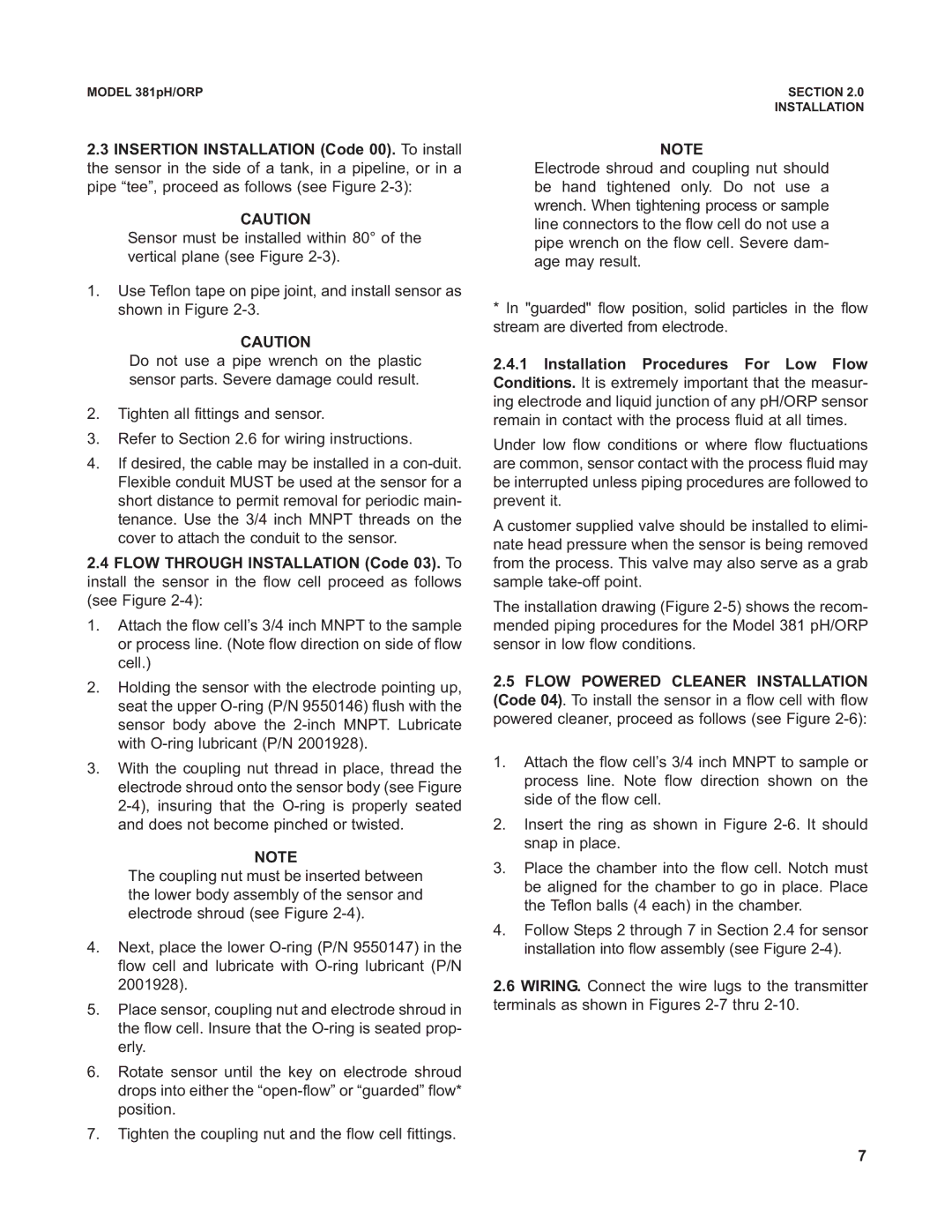MODEL 381pH/ORP | SECTION 2.0 |
| INSTALLATION |
2.3INSERTION INSTALLATION (Code 00). To install the sensor in the side of a tank, in a pipeline, or in a pipe “tee”, proceed as follows (see Figure
CAUTION
Sensor must be installed within 80° of the vertical plane (see Figure
1.Use Teflon tape on pipe joint, and install sensor as shown in Figure
CAUTION
Do not use a pipe wrench on the plastic sensor parts. Severe damage could result.
2.Tighten all fittings and sensor.
3.Refer to Section 2.6 for wiring instructions.
4.If desired, the cable may be installed in a
2.4FLOW THROUGH INSTALLATION (Code 03). To install the sensor in the flow cell proceed as follows (see Figure
1.Attach the flow cell’s 3/4 inch MNPT to the sample or process line. (Note flow direction on side of flow cell.)
2.Holding the sensor with the electrode pointing up, seat the upper
3.With the coupling nut thread in place, thread the electrode shroud onto the sensor body (see Figure
NOTE
The coupling nut must be inserted between the lower body assembly of the sensor and electrode shroud (see Figure
4.Next, place the lower
5.Place sensor, coupling nut and electrode shroud in the flow cell. Insure that the
6.Rotate sensor until the key on electrode shroud drops into either the
7.Tighten the coupling nut and the flow cell fittings.
NOTE
Electrode shroud and coupling nut should be hand tightened only. Do not use a wrench. When tightening process or sample line connectors to the flow cell do not use a pipe wrench on the flow cell. Severe dam- age may result.
*In "guarded" flow position, solid particles in the flow stream are diverted from electrode.
2.4.1Installation Procedures For Low Flow Conditions. It is extremely important that the measur- ing electrode and liquid junction of any pH/ORP sensor remain in contact with the process fluid at all times.
Under low flow conditions or where flow fluctuations are common, sensor contact with the process fluid may be interrupted unless piping procedures are followed to prevent it.
A customer supplied valve should be installed to elimi- nate head pressure when the sensor is being removed from the process. This valve may also serve as a grab sample
The installation drawing (Figure
2.5FLOW POWERED CLEANER INSTALLATION (Code 04). To install the sensor in a flow cell with flow powered cleaner, proceed as follows (see Figure
1.Attach the flow cell’s 3/4 inch MNPT to sample or process line. Note flow direction shown on the side of the flow cell.
2.Insert the ring as shown in Figure
3.Place the chamber into the flow cell. Notch must be aligned for the chamber to go in place. Place the Teflon balls (4 each) in the chamber.
4.Follow Steps 2 through 7 in Section 2.4 for sensor installation into flow assembly (see Figure
2.6WIRING. Connect the wire lugs to the transmitter terminals as shown in Figures
7
